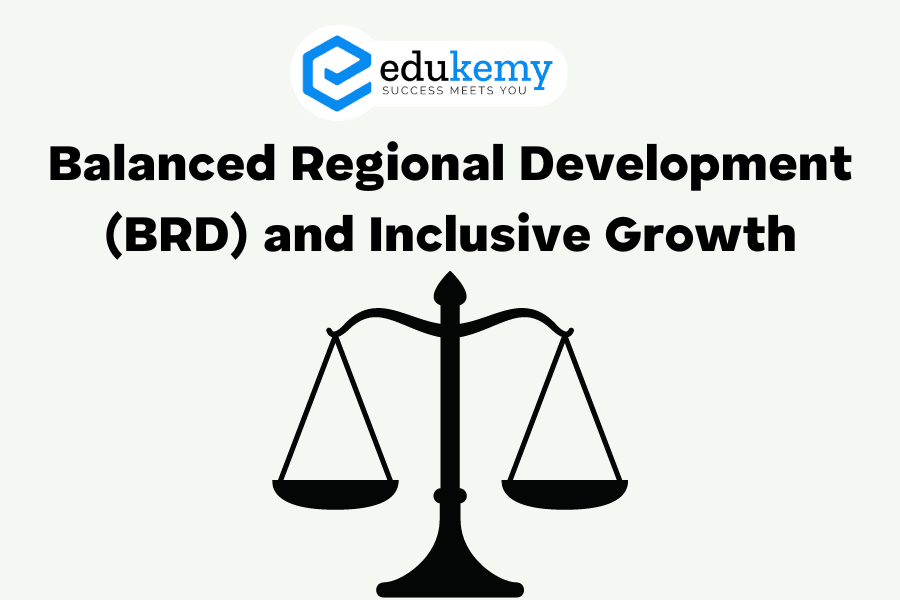
Balanced Regional Development (BRD) and Inclusive Growth stand as cornerstones in the pursuit of equitable economic progress and societal well-being. BRD aims to mitigate regional disparities by fostering even distribution of resources, infrastructure, and opportunities across different geographic areas within a nation or a region. In contrast, Inclusive Growth emphasizes economic expansion that benefits all segments of society, especially the marginalized and underprivileged, ensuring that the fruits of development are shared equitably. These concepts are intertwined, serving as frameworks for policymakers to address socio-economic inequalities and promote sustainable development. Through strategic planning and targeted interventions, BRD and Inclusive Growth aspire to create resilient economies and vibrant communities where no one is left behind.
Contents
Balanced Regional Development (BRD) and Inclusive Growth:
- Regional Dimension: Growing importance of addressing regional disparities in economic development.
- Backward Regions: Backward districts affected by left-wing extremism hinder development; poor infrastructure, including road connectivity, schools, health facilities, and electricity availability, is a significant constraint.
- Infrastructure Improvement: Key component of regionally inclusive development strategy involves improving infrastructure.
- Government Efforts:
- Special Category States: Special attention to states facing particular challenges.
- Green Revolution in Eastern Region: Agricultural development initiative.
- North-Eastern Region Vision 2020: Strategic vision for the development of the North-East.
- PMGSY (Pradhan Mantri Gram Sadak Yojana): Rural road development program.
- Bharatmala: Infrastructure development initiative, focusing on roads.
- Saubhagya: Initiative for electrification of households.
- DDY (Deendayal Upadhyaya Gram Jyoti Yojana): Rural electrification scheme.
- PMAY (Pradhan Mantri Awas Yojana): Affordable housing scheme.
- Aspirational Districts: Targeted development efforts in districts requiring special attention.
Conclusion: Addressing inter-group equality and achieving inclusiveness involves recognizing and mitigating disparities among various identity groups. Efforts toward balanced regional development and inclusive growth require strategic initiatives, focusing on infrastructure improvement and targeted programs for regions facing specific challenges. The mentioned government efforts underscore a commitment to address regional disparities and promote inclusive development across the country.
Empowered Action Group (EAG):
Formation and Objective:
- Formation: Constituted under the Ministry of Health and Family Welfare after the 2001 census.
- Objective: Stabilize population growth in eight states known as EAG states, which include Bihar, Jharkhand, Uttar Pradesh, Uttarakhand, Rajasthan, Madhya Pradesh, Chhattisgarh, and Odisha. These states constitute over 45% of India’s population.
Issues and Governance:
- Fund Availability: Challenges in EAG states are more related to governance than fund availability.
- Systemic Issues: Key areas like human resource management, logistics, fund release, autonomy to districts and PRIs need systemic improvements.
- Strengthening Governance: Focus on strengthening governance and monitoring systems in EAG states.
- Community Involvement: Emphasizes successful community involvement through local empowerment and convergence of efforts.
- Centre-State Coordination: Highlights the need to strengthen coordination between the center and states before direct interventions at the district level.
FAQs
1. What is Balanced Regional Development (BRD)?
- Balanced Regional Development (BRD) refers to a comprehensive approach aimed at reducing regional disparities by promoting equitable growth across different geographic areas within a country or region. It involves strategies to ensure that economic, social, and infrastructural development opportunities are distributed fairly across regions, thereby fostering overall national development.
2. Why is BRD important?
- BRD is crucial for promoting inclusive growth and addressing inequalities within a country or region. By ensuring that all regions have access to opportunities for development, BRD can help alleviate poverty, reduce socio-economic disparities, and promote stability and cohesion within society. Additionally, BRD can contribute to sustainable economic growth by harnessing the potential of diverse regions and leveraging their unique strengths.
3. What are the key strategies for achieving BRD?
- Key strategies for achieving BRD include:
- Investing in infrastructure development such as transportation, communication, and utilities to connect regions and facilitate economic activities.
- Promoting policies that attract investment and encourage business development in underdeveloped regions.
- Supporting education and skill development initiatives to enhance the human capital of disadvantaged regions.
- Implementing targeted social programs to address specific needs and challenges faced by marginalized communities in different regions.
- Encouraging regional cooperation and collaboration to leverage resources and expertise for mutual benefit.
4. What is Inclusive Growth?
- Inclusive Growth refers to a development model that ensures the benefits of economic growth are shared equitably across all segments of society, including marginalized groups. It emphasizes creating opportunities for all individuals to participate in and benefit from the growth process, regardless of their socio-economic background, gender, ethnicity, or location.
5. How does BRD contribute to Inclusive Growth?
- BRD plays a vital role in promoting Inclusive Growth by addressing regional disparities and ensuring that no region or community is left behind in the development process. By fostering balanced development across different regions, BRD creates opportunities for all individuals to access education, healthcare, employment, and other essential services, thereby reducing inequalities and promoting social inclusion. In this way, BRD contributes to creating a more equitable and sustainable society where everyone can contribute to and benefit from economic growth.
In case you still have your doubts, contact us on 9811333901.
For UPSC Prelims Resources, Click here
For Daily Updates and Study Material:
Join our Telegram Channel – Edukemy for IAS
- 1. Learn through Videos – here
- 2. Be Exam Ready by Practicing Daily MCQs – here
- 3. Daily Newsletter – Get all your Current Affairs Covered – here
- 4. Mains Answer Writing Practice – here

